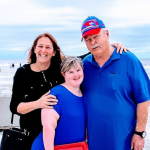Last time we talked about the information you needed to provide to hospital staff if you had to leave your loved one with a disability in the hospital alone. We have heard from families across the country, and the separation is unimaginable. They report feeling beaten down, scared, worried, and exhausted by their own thoughts. Some explain a “gut wrenching” feeling is always there. They ask, “How can I keep my loved one less vulnerable when I am not with them? I have always been by their side, holding their hand, protecting them, calming them, and sometimes being their voice during a hospital admission.”
 Although there is not a simple answer, there are some things that can help. Go back in time when you were with your loved one in the hospital. Think about how you can manage those same things from a distance. We understand things that give you power and control take courage. Be persistent, consistent, and do not give up. Strategizing new tactics, if necessary, can give you hope and a sense of power.
Although there is not a simple answer, there are some things that can help. Go back in time when you were with your loved one in the hospital. Think about how you can manage those same things from a distance. We understand things that give you power and control take courage. Be persistent, consistent, and do not give up. Strategizing new tactics, if necessary, can give you hope and a sense of power.
Do not allow nightmare scenarios of helplessness (are they warm, comfortable, scared…) to play over and over in your head and immobilize you. Focus on what you do know: You are doing the best you can. While showing love in isolation is hard, it IS possible. It is important to remember you have advocacy tools that you can use: you know what is best, what is needed and what is important to keep your loved one safe. Put yourself in “advocacy warrior” mode. What we know to be true is still true, you are the protector. Bring your competent self. You are fearless, creative and resourceful.
One family’s account:
My mother was the only one with my brother in the ER and the hospital made her leave that night, once it was time for him to go to the ICU. We had two friends who work in the top administration of the hospital and we felt they could help us. The next day, we spoke with one of our friends and she was able to get my mom in the hospital for the day. Not knowing until the end of the day, my mom was not allowed to go back. She coughed 3 times and they were concerned. So the next day, we called again and kept calling until we got a response. They let my dad go up there to be with my brother because he was having a procedure done. But the next day came, and no one was allowed to go up there. We again got on the phone with everyone we knew, calling people multiple times. We were turned down by the CEO and other high-up professionals but, we didn’t stop. Eventually, the charge nurse and doctor allowed my mom and she was able to stay. Honestly, the only thing I can say is that we remained consistent and didn’t give up. We did not accept no as an answer.
If you do not know someone who works at the hospital, reach out to your community and  social media network. Find an employee who works at the hospital by reaching out to your neighbors, colleagues, friends, relatives, and social media community. Ask if anyone knows someone who works at the hospital who would be willing to look in on your loved one. You will be surprised how small your community really is and how large your network is. During this unprecedented time people are thankful for the moments of joy they can share. Looking in on a neighbor or friend’s loved one can give a sense of hope to an otherwise helpless situation. Making that connection can be invaluable for everyone.
social media network. Find an employee who works at the hospital by reaching out to your neighbors, colleagues, friends, relatives, and social media community. Ask if anyone knows someone who works at the hospital who would be willing to look in on your loved one. You will be surprised how small your community really is and how large your network is. During this unprecedented time people are thankful for the moments of joy they can share. Looking in on a neighbor or friend’s loved one can give a sense of hope to an otherwise helpless situation. Making that connection can be invaluable for everyone.
Having someone on the inside can be your personal connection to the staff caring for your loved one. By simply checking in, hospital caregivers will see your loved one in a new light: as a person with family and friends, not simply a patient, person with a disability or sick person. Just a few minutes of their time (reading a card, delivering a message from you, turning on some favorite music, etc.) can change the way a caregiver relates to your loved one. People like to be helpful and sometimes they just need to see how to best accomplish this! Your loved one is less vulnerable when people can relate to them.
Another family’s story:
I have always been at the hospital 24/7 when my loved one with a disability is admitted. I make sure I know the names and faces of all staff providing his care. I tell everyone about my loved one when they are not sick (student, employee, athlete, best friend). I quickly learn who I can depend on for support, medical information, patience (not always the same person). I want to know WHAT to ask the doctor during rounds so I do my homework beforehand. I ask questions of the nurses and other hospital staff to help me prepare.
After leaving my loved one in the hospital alone, panic set in. How can I get to know the staff? How do I find out what to ask the doctor? I had to be creative. I requested that all labs and radiology reports be sent to me. My dear friend, a nurse practitioner, offered to look at them for me. This was so helpful. She outlined some specific questions I could ask the doctor.
Until you are able to be by their side, be sure to connect, call, write. Find that direct line of communication to your loved one. Human contact is so important, if you cannot hold their hand or touch their face, hearing your voice can be so comforting. Telling them “We love you. Sorry you are sick. I wish I could hold you.” can be empowering and comforting during this period of isolation. Being able to get this message to your loved one can also be everything to both of you. That personal connection, even without physical contact, is enormously important.
YOUR ADVOCACY IS WORKING. You and your loved one’s civil rights are still intact. Since the last blog, many hospitals have revised visitor policies and are allowing a caregiver in (with specific criteria).
If you are prohibited from accompanying your loved one with a disability to the doctor or medical clinic DO NOT take no for an answer. Ask to see the policy. One family was initially refused access to a medical clinic until they made a few phone calls. The clinic actually had a policy in place that the clinic staff was unaware of. Contact corporate (if appropriate) or call the Protection and Advocacy Office in your state. You may find there is a policy in place after all.
While we find that a less technical approach is getting some good results, the Communication First guide is a good guide for legal references to federal civil rights laws if you want all the federal laws in one place.
TASH has a wealth of excellent resources here.
The TASH-sponsored webinar, Tools for Supporting People When Familiar Supports Aren’t Available, featuring Lori Shepard and Jenny Lengyel, answers the “What if I can’t be there for my family member or the person I support?” questions. The presenters shared how calendars, social stories, social media and other tools can help alleviate stress as we shelter in place.
Next week we will share some of the successful advocacy families and advocates have used asserting the federal civil rights laws to keep people with disabilities safe in the hospital.
 Denise Quigley has advocated for the rights of people with disabilities at the Georgia Advocacy Office for nearly 25 years. Like many of us, she is concerned about the ways we can continue to support the people we stand beside while in the midst of a pandemic.
Denise Quigley has advocated for the rights of people with disabilities at the Georgia Advocacy Office for nearly 25 years. Like many of us, she is concerned about the ways we can continue to support the people we stand beside while in the midst of a pandemic.
